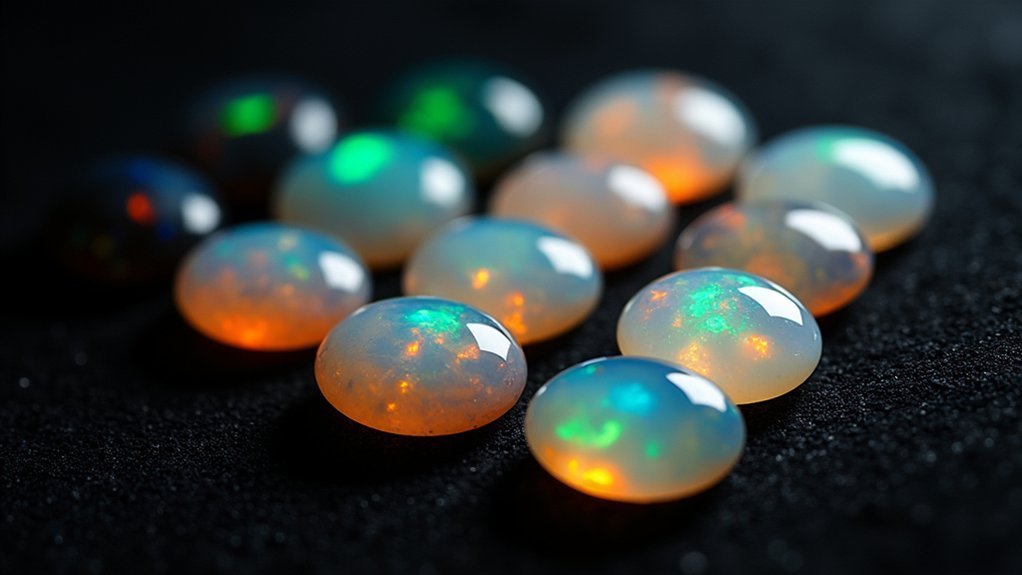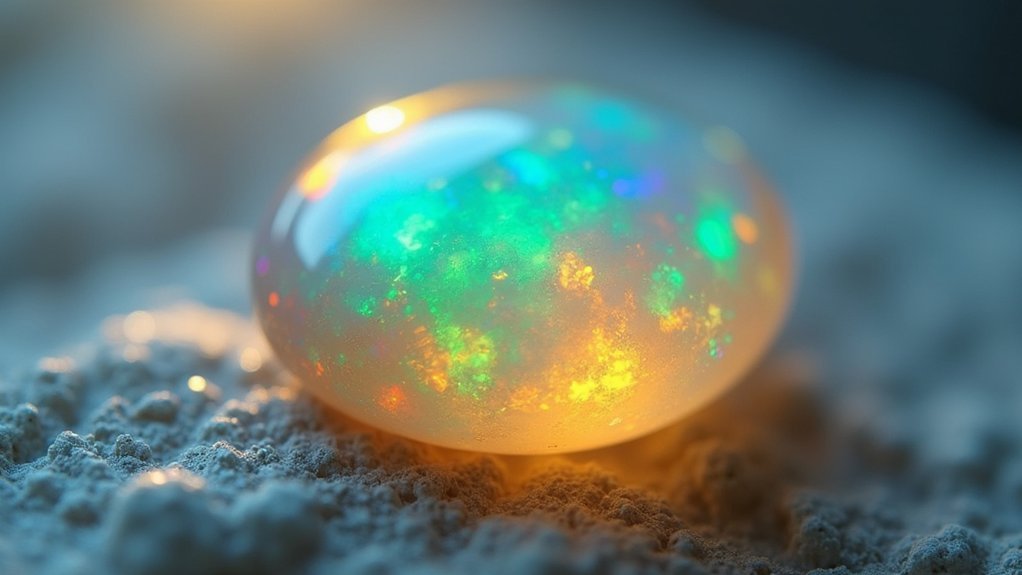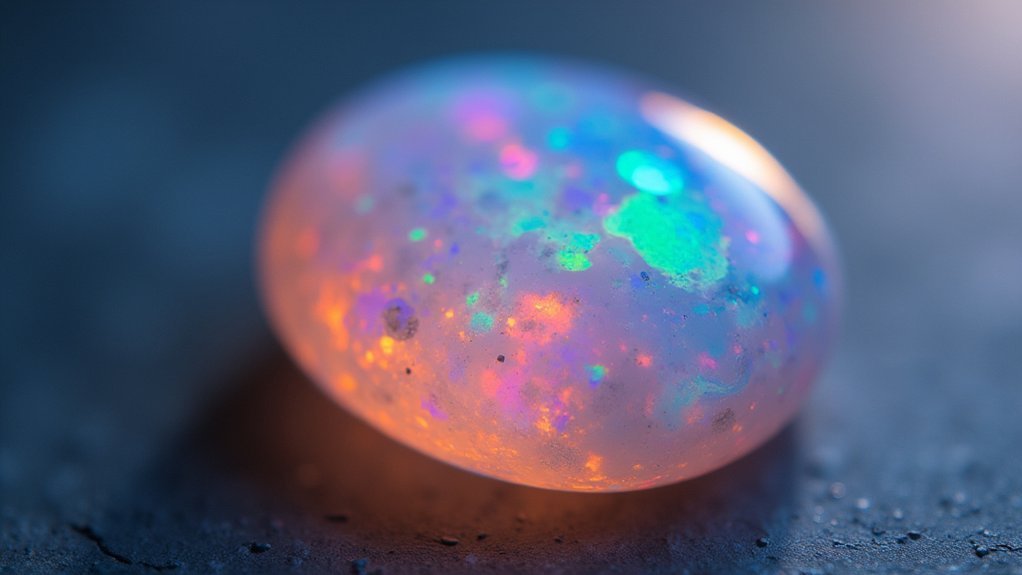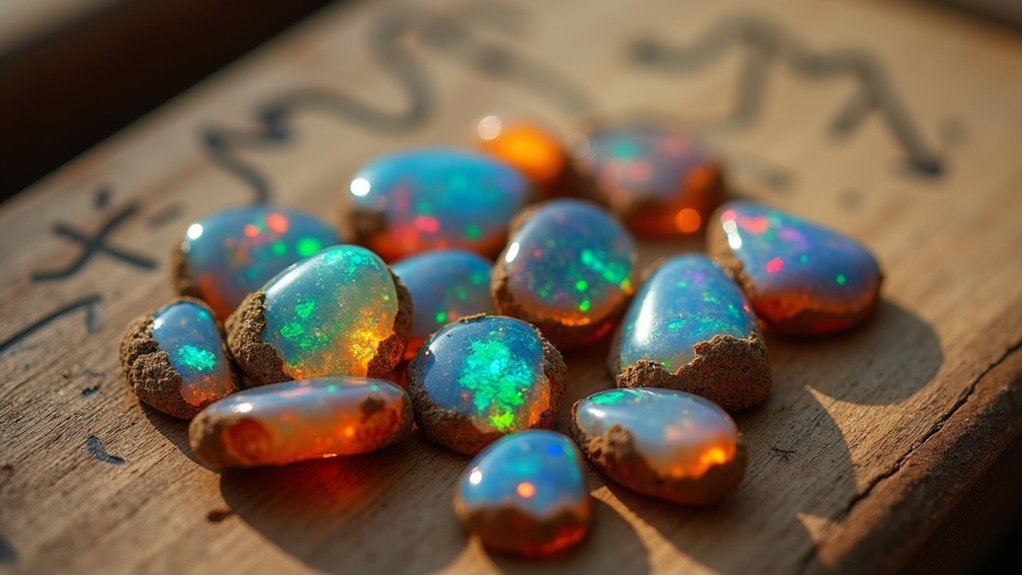Opals are graded on body tone (darker is better), play-of-color intensity (vibrant colors command premium prices), transparency, clarity (fewer inclusions increase value), color distribution (harlequin patterns are coveted), cut quality (60-75% dome height is ideal), durability, origin (Australian black opals are prized), and classification (natural vs. composite). Size matters less than quality, with small vibrant opals often worth more than larger, duller stones. These factors together determine an opal’s true market value.
Body Tone: From Black to White

When evaluating an opal’s quality, body tone serves as the foundation for its overall value. This critical opal grading factor refers to the background color against which the play-of-color displays itself.
The body tone scale ranges from N1 to N9, with lower numbers representing darker backgrounds. Black opals (N1-N4) are the most prized precious opals due to their dark background that dramatically enhances color contrast and brilliance.
The rarest black opals (N1-N4) command premium prices for their unparalleled ability to showcase vibrant play-of-color against their dark canvas.
You’ll notice how these darker stones make the play-of-color appear more vibrant and intense.
White opals (N9) have a milky or pale gray background that doesn’t showcase the color play as effectively, resulting in lower value.
When examining opals, remember that the darker the body tone, the more valuable the stone typically becomes, assuming other quality factors are equal.
Play-of-Color Intensity and Patterns
Although body tone provides the canvas, the play-of-color intensity and pattern distribution ultimately determine an opal’s true value and beauty.
When evaluating opals, you’ll find that vibrant colors displaying across the spectrum greatly increase market value, with pure red and pink being especially prized for their rarity of colors.
The arrangement of color patches matters tremendously in opal grading. Well-distributed patterns are far superior to scattered dots, with the harlequin pattern—featuring broad, angular color segments—being the most coveted of all opal patterns.
Brightness levels range from B1 (exceptionally brilliant) to B7 (very weak), with B1 stones commanding premium prices since they display intense play-of-color intensity even in subdued lighting.
When shopping for quality opals, prioritize those exhibiting vivid, broad flashes rather than pinpoint color displays.
Transparency and Light Transmission

Three distinct transparency levels define an opal’s light-transmitting properties: opaque, translucent, and transparent.
When evaluating an opal, you’ll notice that transparent specimens allow light to pass freely, translucent ones permit some light transmission, while opaque stones block light completely.
Transparency dramatically affects how you’ll perceive an opal’s play-of-color. Crystal opals, with their semi-transparent to transparent qualities, display more vibrant color patterns because light can penetrate deeper into the stone.
You’ll find that clarity issues like inclusions or cloudiness can diminish both transparency and value.
Watch for crazing—fine cracks that develop from moisture loss—as this can permanently reduce transparency.
When shopping for opals, remember that transparent specimens typically command higher prices due to their superior brilliance and enhanced color display.
Clarity and Inclusion Assessment
The clarity of an opal represents one of its most critical grading factors, directly influencing both its visual appeal and market value. When evaluating clarity grade, jewelers examine visible inclusions like fractures, pits, and matrix fragments that diminish an opal’s beauty. The fewer flaws present, the higher the opal value.
The absence of visible flaws elevates an opal’s beauty and worth, making clarity paramount in gem assessment.
Transparency levels range from transparent to semitransparent to opaque, with clearer specimens typically commanding premium prices.
- Watch for crazing—networks of cracks resulting from moisture loss that affect both aesthetics and durability.
- Electric blue opals with minimal common inclusions represent the pinnacle of clarity, outvaluing milky or pale blue stones.
- Physical and chemical imperfections impact light play within the stone, potentially diminishing the vivid color flashes that make opals cherished.
Distribution of Color Flashes

Color flash distribution across an opal’s surface represents perhaps the most enchanting aspect of these gemstones, directly determining their visual impact and market value.
When evaluating an opal, you’ll want to look for even distribution of color flashes rather than local patches, as harmonious patterns greatly enhance the stone’s appeal.
The play-of-color can manifest in various patterns, with the rare harlequin patterns—displaying large, angular color segments—commanding premium prices in the market.
These distinctive arrangements create a mesmerizing visual effect that collectors prize.
Remember that vibrant flashes spread consistently throughout the stone indicate superior overall quality.
While examining potential purchases, prioritize opals that exhibit balanced color patterns visible from multiple angles, as these specimens maintain their enchanting properties regardless of viewing position.
Size and Carat Weight Considerations
Unlike diamonds and many precious gemstones, opal’s value isn’t primarily determined by its size or carat weight, though these factors certainly play a role in pricing.
When evaluating an Australian Opal, you’ll find that quality, play-of-color, and overall appeal take precedence over mere size measurements. While larger opals typically command higher prices per carat, this relationship isn’t linear across different opal types.
- Body tones greatly impact value – a smaller opal with vibrant color play can be worth more than a larger specimen with minimal flash.
- Standard cabochon sizes (64-86mm) often provide the best balance between wearability and visual impact.
- Pricing structures reflect a holistic assessment where carat weight is just one factor among many quality indicators.
Remember that approximately 90% of opals come from Australia, where size considerations vary by mining region.
Cut Quality and Cabochon Shape

When examining an opal’s value, you’ll want to assess the dome height which should be neither too shallow nor too steep for peak play-of-color.
The symmetry of your cabochon directly affects its visual appeal, with well-balanced proportions creating a more harmonious display of the stone’s natural beauty.
Your opal’s proportions should maintain a thickness that balances durability with the ideal light reflection needed to showcase its unique color flashes.
Optimal Dome Height
The perfect dome height represents one of the most critical aspects of opal cutting that directly impacts the stone’s overall beauty and value. When evaluating opal cabochons, you’ll find the ideal dome height typically ranges between 60-75% of the stone’s diameter. This proportion maximizes brilliance and play-of-color while protecting your opal from damage through better impact distribution.
A well-executed dome shape affects how you perceive the stone’s size—higher domes often appear larger than flatter cuts with identical diameters. However, cutting quality matters considerably; domes that are too flat lack depth and vibrancy, while excessively high ones distort clarity and color perception.
- The dome’s curvature allows light to enter and reflect off internal layers, enhancing brilliance.
- Proper dome proportions showcase the opal’s true color potential across viewing angles.
- Well-balanced height-to-width ratios improve durability in everyday jewelry applications.
Symmetry and Proportions
Beyond dome height, symmetry and proportions represent foundational elements that determine an opal’s ultimate beauty.
When examining a cabochon-cut opal, you’ll want to assess how evenly balanced the stone appears from all angles. Perfect symmetry enhances light reflection, maximizing the play-of-color that makes opals so enchanting.
The proportions of your opal aren’t just about aesthetics—they’re vital for durability. A well-cut stone maintains consistent thickness throughout, preventing potential crazing or cracking when worn as jewelry.
You’ll notice that professional cutters carefully balance these elements while highlighting the stone’s unique patterns.
Some opals may feature custom or freeform shapes specifically designed to showcase exceptional color patterns. While these might deviate from traditional symmetry, they’re intentionally crafted to enhance visual appeal and can command higher prices when the cutting complements the stone’s natural characteristics.
Durability and Structural Integrity
Gemstone enthusiasts often overlook durability when captivated by an opal’s spectacular play-of-color. With a Mohs hardness of only 5.5-6.5, opals require more careful handling than tougher gemstones. Their water content (3-21%) creates their magical appearance but makes them vulnerable to crazing when exposed to temperature extremes or excessive dryness.
When evaluating an opal’s structural integrity, you’ll want to:
- Check for existing surface cracks or signs of previous damage, as these indicate potential weak points
- Confirm if any treatments (oils or resins) have been applied to enhance durability
- Assess whether you’re purchasing a solid opal versus an assembled piece like a doublet or triplet
Proper care, including storage away from sunlight and heat, will greatly extend your opal’s lifespan and preserve its beauty.
Origin and Mining Location Impact

While durability concerns how long your opal will last, where it comes from often determines its initial quality and value.
Australia dominates the opal market, supplying about 90% of the world’s opals, with Lightning Ridge’s black opals commanding premium prices due to their rarity and exceptional play-of-color.
The geographical origin of your opal considerably influences its worth because specific mining locations possess unique mineral compositions that enhance the stone’s visual properties.
For instance, Lightning Ridge’s reputation for producing high-quality opals makes gems from this region particularly valuable.
Meanwhile, Ethiopia has emerged as a notable competitor with opals displaying distinctive color patterns, diversifying the market.
When purchasing an opal, remember that established mining locations with respected reputations typically yield more desirable stones worth your investment.
Natural vs. Composite vs. Synthetic Classification
The classification of an opal fundamentally determines both its value and authenticity in the marketplace.
When you’re evaluating opals, understanding whether you’re looking at natural opals, composite opals, or synthetic opals is essential for accurate assessment.
Natural opals form in nature without treatments, displaying genuine play-of-color and commanding premium prices.
Composite opals (doublets and triplets) combine natural opal layers with backing materials for durability.
Synthetic opals, created in laboratories, mimic natural composition but lack authenticity and typically have lower value.
- Natural opals’ unique characteristics and rarity make them the most valuable classification
- CIBJO guidelines require transparent disclosure of treatments and origins
- Clarity about classification protects you from paying natural opal prices for composite or synthetic alternatives
Frequently Asked Questions
What Are the Different Grades of Opals?
You’ll find opals classified into five quality grades: Heirloom (AAAA), Best (AAA), Better (AA), Good (A), and Poor. Heirloom represents the top 1% with intense play-of-color, while Poor shows minimal desirable characteristics.
What Does AAA Grade Opal Mean?
AAA-grade opal is a premium classification you’ll find in the top 10% of opals. It’s characterized by medium play-of-color, opaque appearance with minimal surface flaws, and a good balance of brightness and clarity.
What Determines the Value of Opals?
The value of your opals depends on their type (precious vs. common), color (red/orange being most valuable), clarity, transparency, and body tone (darker tones often command higher prices). These factors collectively determine their worth.
What Are the Highest Quality Opals?
Heirloom (AAAA) opals are the highest quality you’ll find, representing just 1% of all opals. They’re characterized by their milky appearance, intense play-of-color, clean surface, and opaque quality.
In Summary
As you’ve learned, opal grading isn’t simply about color play. You’ll need to contemplate body tone, pattern distribution, transparency, clarity, cut quality, structural integrity, and origin when evaluating these gems. Don’t forget to distinguish between natural, composite, and synthetic varieties. Armed with these ten factors, you’re now equipped to make informed decisions when purchasing, selling, or simply appreciating these fascinating gemstones.





Leave a Reply